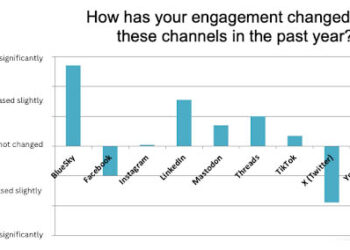 (N.B. — This posting is coauthored by Rick Anderson and Dean Blobaum.)
(N.B. — This posting is coauthored by Rick Anderson and Dean Blobaum.)
Background
In the comments section of a recent Scholarly Kitchen posting by Rick Anderson, a now-familiar point of controversy was raised: to what degree do university presses rely on libraries as customers for their books? It’s a commonplace assertion that, contrary to longstanding popular belief, libraries are not in fact the primary customers of university presses, and this assertion was made again in the comments. Rick expressed his belief that while this is true of university press publications generally, it’s probably not true of scholarly monographs specifically, and that the decrease in libraries’ share of university press purchases probably has mainly to do with the larger number of non-scholarly books being published by university presses.
Into the fray waded Dean Blobaum, Electronic Marketing Manager at the University of Chicago Press (UCP), who offered a test of Rick’s hypothesis. “Pick 10 (scholarly) monographs published by Chicago,” he said, “and I’ll tell you what percentage of the sales of those books is represented by their WorldCat holdings.” (For those unfamiliar with it, WorldCat is a collective library catalog reflecting the holdings of roughly 72,000 libraries around the world.)
It was a great idea, and Rick took Dean up on the challenge, selecting ten scholarly titles from the previous year’s UCP offerings and submitting the list to Dean for analysis. The result: 49% of the sales represented by those ten titles could be accounted for by library holdings registered in WorldCat.
Rick and Dean kept talking. We wondered how this number might change with a larger sample—recognizing both that the line between “scholarly” and “nonscholarly” can be blurry and that, due to the very large number of individuals in the world and the much smaller number of libraries, over time libraries would inevitably constitute a smaller and smaller percentage of sales for any particular title.
We decided to replicate the ten-title study using the whole output of UCP during the year 2012. This amounted to 326 books in total, in eight format categories and fifteen identified subjects. By examining the sales and library holdings data for all 326 books, we hoped to get a better idea of how library purchasing is distributed among subject areas and book types. Because detailed sales data has competitive value, we knew we would have to present it carefully. Dean consulted with executives at UCP and got permission to present the data publicly as long as it was made available only in format and subject aggregations.
Accordingly, Dean sent Rick a spreadsheet listing the 326 books published by UCP in 2012, along with bibliographic data. Using ISBN as a matchpoint, Rick looked up each title in WorldCat and recorded the number of holdings reflected there, then returned the list to Dean, who pulled the sales figures for each book and computed the percentage of sales represented by WorldCat holdings. The results can be seen in the two tables below, one of them organized by book format or type and the other by BISAC subject. Following the tables, commentary and analysis are provided by Dean (who will also explain the logic behind the data categories) and by Rick.
Table 1: Sales by Book Type
| Type | # Titles in Type | % sales in WorldCat |
| Annual | 9 | 13.68% |
| Edited Collection | 21 | 38.35% |
| IH reprint | 68 | 8.82% |
| Monograph | 127 | 46.70% |
| New edition | 19 | 10.99% |
| OOH reprint | 13 | 8.55% |
| Plus monograph | 22 | 29.05% |
| Trade | 47 | 22.58% |
Table 2: Sales of Scholarly Monographs by Subject
| Subject (BISAC) | # Titles in Subject | % sales in WorldCat |
| Art and Art History | 9 | 41.87% |
| Economics and Business | 11 | 37.72% |
| Education | 5 | 34.65% |
| History | 40 | 51.35% |
| Law and Legal Studies | 4 | 42.42% |
| Literary Studies | 15 | 52.74% |
| Medical Topics | 2 | 24.69% |
| Music | 6 | 58.81% |
| Philosophy | 11 | 43.35% |
| Political Science | 14 | 39.65% |
| Psychology | 1 | 48.78% |
| Reference | 2 | 18.83% |
| Religious Studies | 5 | 39.86% |
| Sciences | 16 | 47.56% |
| Social Sciences | 29 | 31.54% |
Dean’s Comments
What is this data? The titles the University of Chicago Press published in 2012 were categorized by type (basically to separate out the purely scholarly books from other titles) and by subject (using the publishing industry’s BISAC classifications). For each of 326 titles, Rick provided the number of libraries holding that title as reported in WorldCat and I compared that number to each title’s unit sales-to-date. Both numbers, then, at least attempt to include all formats of the work – print formats and e-book formats.
The types are Annuals, Edited Collections (scholarly), In-house Reprints (paperback editions released in 2012 of books previously published by UCP in cloth), Scholarly Monographs, New Editions of works previously published, Out of House Reprints (paperbacks released in 2012 of books previously published elsewhere), Plus Monographs (monographs UCP saw as having a modest audience beyond the academy and gave a fullpage in our seasonal catalog), and Trade (books intended for bookseller stock and general readers).
The percent of sales held in libraries was calculated for each title and then the average percent was calculated by type of book and subject. However, to keep the focus on scholarship, the titles included in the Subject Totals were restricted to Monographs, Plus Monographs, and Edited Collections. The reason to exclude the other categories? Those other categories do not help get at the issue of scholarly monographs in libraries. Trade books will sell well beyond the library; Reprints are complicated by editions that might not be tied together in WorldCat (and our Out of House Reprints are typically trade anyway); Annuals have both ISBNs and ISSNs so the WorldCat data for those might be skewed; and New Editions are pretty much by definition not monographs.
Let’s offer one important caveat upfront: this is a small sample, one publisher’s books for one year. Other publishers’ mileage may vary. But what does this sample of data suggest about scholarly books from university presses in libraries? First, that libraries don’t have a monopoly on the monograph, but they are absolutely a vital piece of the dissemination of that scholarship.
It is interesting to me that the Plus Monograph category seems to behave quite a bit more like the Trade category than like the Monograph category. We expect, of course, that our Trade titles will sell more broadly, but I’m actually surprised that Monograph Plus has library representation closer to the Trade profile. It looks like our sense that “this is a more important monograph” doesn’t really translate to greater library representation, even if it does translate to higher sales overall.
The highest representation in libraries is in the book-focused disciplines: History, Literary Studies, and Philosophy. Our Science titles also have better library representation, perhaps reflecting that the core of our science list is in the history and philosophy of science. Our Music titles, likewise, are well-represented and our music titles are typically music history.
Does the relatively lower percentage of holdings in Art and Art History reflect the relatively higher prices of those books? Or the fact that they are beautifully illustrated objects that people like to own?
Does the data speak to issues of patron-driven or demand-driven acquisition? Individuals comprise more than half the market for the monograph; arguably there is a need that some libraries are not meeting. If a librarian thought like a marketer, the librarian would look at those sales to individuals and say: “I want those readers to use my library. How can I convert some of those book buyers into library users?” (On the other hand, if a librarian thought like an accountant, the librarian would say: “Every book an individual buys is one I don’t have to buy. More power to them!”)
Again, it’s important to bear in mind that we’re looking at one publisher’s books for one year – and a university press publisher, one which, like other university presses, is able to set prices for its books that do not put them out of reach of individual buyers. For that economy, we owe the support we get from our university, the lift from books we publish for a general or regional readership, the book reviewers who read and like those books, the students who purchase books assigned in courses, and the support of libraries who purchase the work of our authors.
Rick’s Comments
From the beginning of this exercise, my primary question has been about those publications that can be categorized as scholarly monographs—I have never doubted that the more generalist and popular titles published by university presses are purchased more heavily by individuals than by libraries. My belief was that libraries (particularly academic libraries) constitute the primary market for true scholarly monographs. The data provided here suggest that I’ve been mistaken about that. While library holdings (as reflected in WorldCat) represent a very significant portion of scholarly monograph sales in total—nearly half—these data do not support my belief that library purchases constitute the majority of sales for scholarly monographs in the aggregate. Furthermore, they suggest that the common view that libraries account for only somewhere between 20 and 25% of total university press sales is right on: in 2012, WorldCat holdings represented 22.34% of UCP book sales.
Looking at the breakdown of sales to libraries by subject, the data become even more interesting. Because (as Dean explains above) this data set drills down specifically into the sales patterns for scholarly monographs, it suggests that in some subject areas library purchases do, in fact, constitute the majority of sales—notably, in two of the three most productive subjects listed (History and Literary Studies). This doesn’t do much to change the incorrectness of my original belief about the importance of library purchasing for scholarly monographs generally, but it’s certainly interesting.
Other results of this study confirm what I (and probably most of us) would have assumed to be the case: that annuals, reprints, and new editions sell to libraries in very small numbers (from my several years of experience as a bookseller to libraries, I would have guessed that fewer than 10% of those sales would be represented in WorldCat), and that non-library purchases of trade books would greatly outstrip sales to libraries. Even though these findings are unsurprising, I think it’s worthwhile to have the data.
There are, of course, some caveats about this data set. First of all, UCP is only one of many university presses, so the results here are only suggestive about larger patterns in the scholarly-book marketplace. Second, we are assuming that WorldCat offers comprehensive information about library holdings. That’s an assumption with which I’m pretty comfortable for the purposes of this study, but it’s worth making explicit. And it’s also worth noting that the term “monograph” is a squishy one; even if we replicated these data with 100 other university presses, there’s no guarantee that all would categorize their books by type in exactly the same way. This kind of study can only be so rigorous.
Discussion
37 Thoughts on "How Important Are Library Sales to the University Press? One Case Study"
Second, we are assuming that WorldCat offers comprehensive information about library holdings. That’s an assumption with which I’m pretty comfortable for the purposes of this study
I would not be comfortable with that assumption at all. As I’m sure you know, many libraries do not list their collections in WorldCat at all – this is particularly true for special libraries at think tanks and other non-profits, law firms and corporations, the courts, government agencies, etc., but also some colleges/universities, and probably quite a lot of public libraries. Worldcat is also not very good at representing copies held at several different libraries in a system – whether a public one like the NYPL, or a university’s, with different locations on different campuses or even within one campus.
So, the percentages that you have identified are definitely minimum numbers, but the “real” percentages are likely at least somewhat higher.
– Mikhail Koulikov, MLS
Mikhail, you raise a good point — hence the very important qualifier “for the purposes of this study.” WorldCat holdings data would not represent a rigorous-enough data set to constitute a comprehensive study of library collections.
On the other hand, I have found Worldcat includes “false positive” listings, claims that cannot be verified in the member libraries’ catalogs. Thus the percentages may not even be “minimum numbers.” But then, I don’t believe Worldcat was designed for statistical analysis of book sales.
Rick:
Very interesting data and it seems to follow STEM book sales patterns. However, the questions remain: 1) How many copies are sold and 2) are the books making enough money to support the press?
Our list, entirely in the areas of politics, international relations, and sociology, behaves similarly: about 50% of our sales are to libraries (though most of these sales go through library suppliers, not directly to the institutions).
Interesting article.
From a UK perspective, with dwindling budgets for buying books, certainly with the public library sector, there has been a noticeable reluctance to purchase UP titles, given there often higher associated costs.
Equally there seems to be a reluctance within some UP to make there titles more widely available. I say that in the sense of advertising them outside of a narrow shop window-usually restricted to journal reviews or ‘high end’ publications. I’ve often been left wondering if some UP actually want a bigger audience!
Prices for university press books (at least U.S. presses) have been shown by studies by Al Greco and others to be significantly cheaper than prices of comparable books published by commercial academic publishers. So, your first claim is false.
What would be the point of presses doing wider advertising for monographs, whose target audience is very specialized? That would just be a waste of scare resources. The marginal sales that such wider advertising might generate would not even cover those marketing costs.
I think both comments are true – UP prices are higher than most books purchased by public libraries, and UP prices are also generally lower than academic-oriented commercial publishers (eg Springer). However, few public libraries buy very many titles from the likes of Springer…
That is true. However, they do buy Springer’s massive database that is populated with the books they publish.
Harvey, I doubt that you’d find more than a tiny handful of public libraries that purchase Springer’s ebook collections. In fact, I’d be shocked if you could count them on more than one hand.
Their market is academic libraries and them seem to be doing well in penetrating that market.
Well, right — but you were responding to Andrew’s comment about purchasing patterns in public libraries, not academic ones.
Sorry.
Hi Sandy
Appreciate the response.
I will concede that the price in the USA maybe competitive to other authoritative publishers (though I doubt universally) but that’s certainly not the case in the UK.
In terms of ‘advertising and marketing’ the UP in both the US/UK is broadly similar. It’s aimed at the Journal or LRB readership for example, whereas many of there titles would benefit from a broader readership, which often concentrates outside such rarified environments (forums or websites) or read various blogs etc. Many UP seem disinterested unless you work for a paper based publication.
Thanks
Andy
Actually, there is a broader market in the UK for serious academic nonfiction than in the U.S. Witness the TLS, which has no counterpart in the U.S. (not even the New York Review of Books). Also, commercial presses like Polity are able to publish works of scholarly synthesis, which seem to have a market in the UK that does not exist in the U.S.
One thought: while it’s reasonable to assume that most libraries will buy one copy of a scholarly monograph rather than two or three, there’s a number of cases where a Worldcat entry represents both general and specialist libraries in a university, or multiple campuses, where it’s more likely you’d see some duplication.
So even for libraries *known* to be reflected in Worldcat – and I agree this is a reasonable sample – you’ll still get a degree of undercounting.
(I’ve just tested this for a CUP book I know from experience is widely held at Cambridge – Worldcat has one entry, but the local catalogue reports 23 copies. An extreme case, but still…)
Well, I can’t speak for books for Cambridge, but I am quite confident in saying that if a
Iibrary holds 23 copies of a Chicago book, that book assuredly is not a scholarly monograph.
I may be counting wrong, but it looks like the Harvard Libraries (combined) have 33 copies of the 1970 edition of The Structure of Scientific Revolutions.
Limited though it is, this study is very valuable for just producing some data in an environment where hard data are scarce. One additional caveat is in order, though. The BISAC codes are ill suited for scholarly books, as I argued in this article from Against the Grain: https://scholarsphere.psu.edu/files/9880vr69g. For one thing, what sense does it make to call one category “Social Sciences” when economics, political science, and psychology have their own separate categories? The BISAC codes were designed for trade titles sold through regular retail bookstores, which are not the main avenue of sales for monographs.
Public libraries frequently buy many copies of titles, including UCP2012 titles. One title, Dreaming in French, created 11 sales to a local public library. I agree with Andrew that this research can only suggest the minimal number of sales to libraries.
I’m interested in Dean’s comment “Does the data speak to issues of patron-driven or demand-driven acquisition? Individuals comprise more than half the market for the monograph; arguably there is a need that some libraries are not meeting.”
Could you expand on that statement? I’m not sure where you were going with it. Was it that libraries are not making sufficient use of DDA? And if they were, the books would be available via the library? Are libraries too narrow in scope in what they are purchasing?
The premise of PDA is that “the market will speak to us and then will will acquire the book.” In fact, a significant portion of the market has already spoken and it has bypassed the library. Is PDA going to help libraries recover the scholars that have already decided it does not serve their needs? Libraries must decide if their purchasing serves their constituency, but as a marketer I would certainly, as a librarian, regard scholars that buy scholarly monographs as a piece of the market I should try to recapture.
Dean, I think your understanding of the PDA premise is a bit off-target. I think it would be more accurate to say that the premise of PDA (for academic libraries, anyway) is twofold: first, it’s “we want to offer access to more books,” and second, it’s “we can’t afford to buy books that no one wants us to buy.” As academic librarians, “market capture” is kind of an alien concept to us — the market for our collections is defined by our campus communities. The purpose of our collections is to make the scholarly work of those communities possible, and one of the biggest challenges we face in doing so is the fact that we have insufficient money and space for the resources they require. In light of those constraints, buying books for which there’s no local demand is a mistake. That’s the problem that PDA emerged to help us solve. If a member of our campus community buys a copy of a scholarly book for herself, we don’t see that as a loss of market share for the library–it suggests that she wanted to own a copy rather than borrow one. Book ownership is something that booksellers offer to their customers and libraries do not. We don’t compete with them on that field.
Hi Rick
Do the University libraries get or have a reciprocal agreements with UP where they get books at a high discount, so mitigating some of the expense?
Thanks
Andy
Has PDA uptake grown enough so that monograph sales to libraries may have a longer tail that we’re not yet seeing in these numbers? Or I guess the question would be had it grown enough by 2012. Could sales triggered in the years after release now be significant enough to shift the typical libraries/individuals sales ratios for mid- and backlist titles?
Reblogged this on Progressive Geographies and commented:
Interesting thoughts (and data from University of Chicago Press) on book publishing and library sales.
Reblogged this on DailyHistory.org and commented:
Rick Anderson and Dean Blobaum at the Scholarly Kitchen have attempted to determine what percentage of a university press sales were made by libraries. Surprisingly, the University of Chicago Press provided data to the authors to help them answer this question. While the methods they used were not necessary perfect, they give us a better understanding of how important the library book market is to presses. The results are very interesting.
One thing that I think is worth noting here is that this is looking at books published in 2012 and sales from these book’s first year or so on the market. I hope no one is thinking that means almost half of any monograph’s revenue is derived from the library market. In truth, over a monograph’s long lifetime, significantly more than half of the revenue will come from sales to individuals. For UPs with a mature backlist, more than half of their expenses are paid by those sales to individuals, not by sales to libraries. I’ve long questioned the utility of having scholarship engage in markets at all, especially when enduring the argument that sales are some kind of measurement of quality, but I am growing more and more aware of how useful and efficient markets are in dissemination. My greatest concern these days is how the decline in library sales is having the unintended consequence of raising prices on the sales to individuals. When only well heeled, tenured faculty can afford our books, and libraries begin to stop buying them or instead only rent them, we are all failing undergraduate and graduate students who are already at their financial limits with tuition and textbooks.
I recently heard an academic publisher describe the rising prices of scholarly books as a potential advantage, offering theses books a certain cache, comparing them to luxury autos and jewelry where higher prices can confer higher quality. Perhaps they were trying to put a positive spin on a difficult dilemma, but I found that a nauseating rationalization for pricing, and one that ignores those students and even junior faculty. I’ve even had librarians tell me that we should price our books higher because our prices were still so much lower than STEM/for-profit content. But as our prices go up, we begin to fail individuals who may not have a library that thinks a particular book is appropriate for their collection, or individuals who use texts in ways that require ownership, and we further entrench an economic elitism that really has no place in education.
Rick: Thanks for trying to move this debate from speculation and dogma to evidence.


